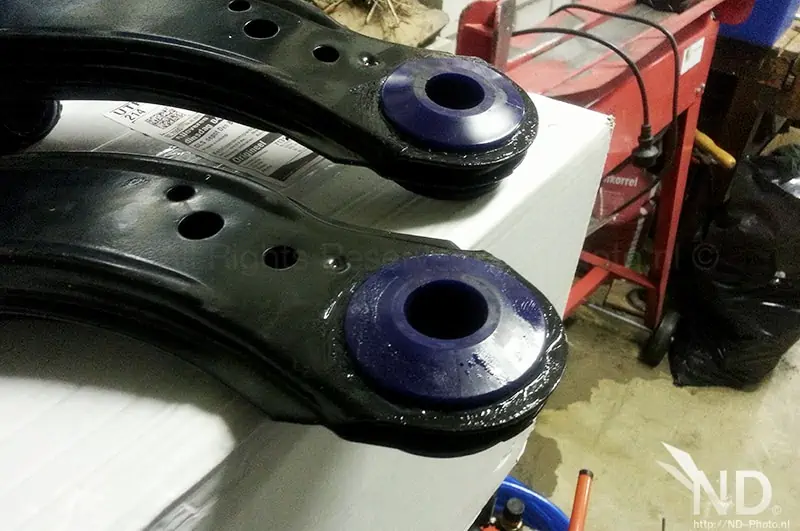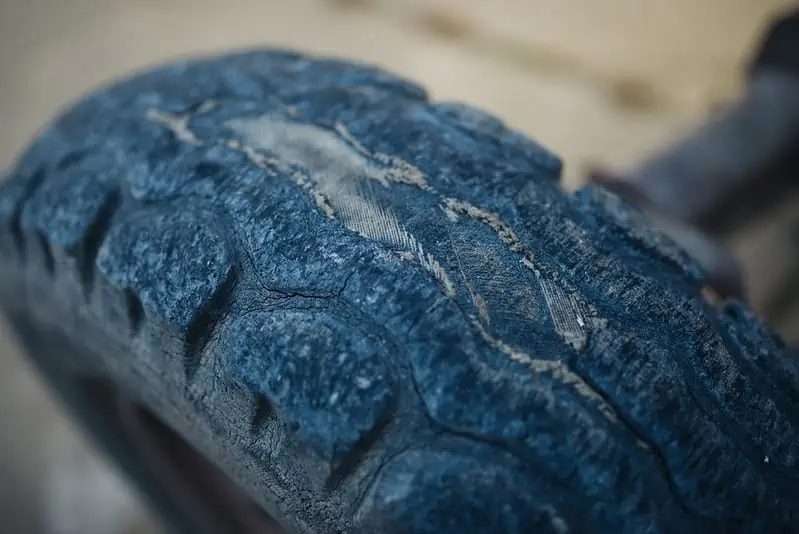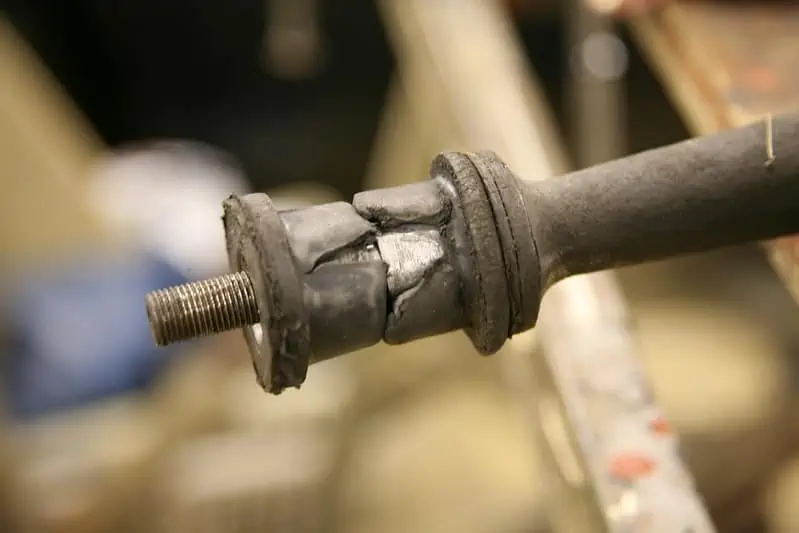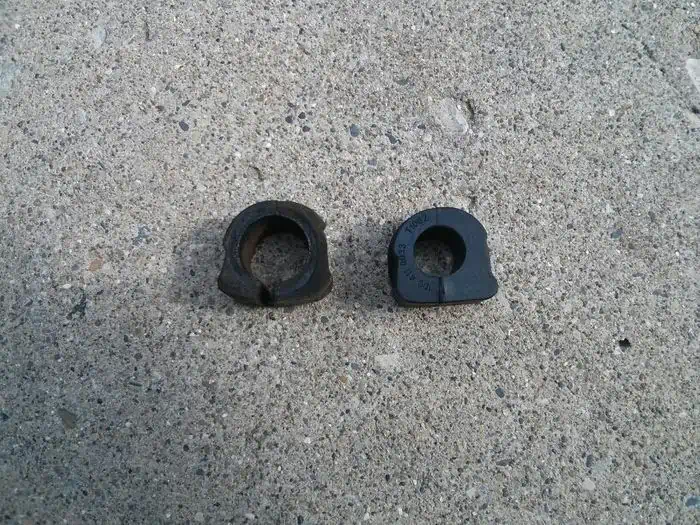Most drivers probably do not give much thought to their vehicle’s control arm bushings. After all, they only serve to protect your automobile from bouncing around as you drive, right? Well, this is not entirely accurate. Control arm bushings play a crucial function in maintaining vehicle control and handling. They attach the ball joint to the vehicle’s suspension and regulate the amount of movement in the wheel assembly. They also transmit the suspension forces to the vehicle’s actual chassis.
Over time, these bushings can wear down and start to wear out or leak oil. This can lead to various problems and pose a safety risk to you and other motorists on the road. To enable you to accurately diagnose a defunct control arm bushing, we will extensively discuss symptoms to look out for in this article.
Control Arm Bushings and their Functions
A control arm bushing by Nathanael Burton / CC BY-SA 2.0
A control arm bushing is a component that attaches your vehicle’s control arms to its frame.
Control arms are components of your steering and suspension systems that allow your car’s wheels to freely move while remaining attached to the vehicle. It contributes to the overall stability of the vehicle while also providing a pleasant ride for the driver. The control arm connects the chassis to the rest of the suspension system and serves as a pivot point for the wheels, allowing them to move up and down as the car goes along the road. It also absorbs the force of road bumps and keeps the wheels firmly planted on the ground for increased traction and stability. The bushings play a primary role in the function of this critical component of the suspension system by allowing them to pivot freely as the wheels turn. If the bushings become damaged or worn, they can begin to bind and make the system less effective at providing a comfortable ride.
There are two types of control arms: upper control arms and lower control arms with a side-mounted rubber bushing. An upper control arm is attached at the top of the spring and shock absorbers, and a lower control arm is attached at the bottom of the spring and shock absorbers. The upper control arm of your car aids in the rotation of the front wheels, making them an essential component of your steering system.
Most front-wheel drive budget cars have only lower control arms, while other vehicles, including SUVs and trucks, have both upper and lower control arms in a double-wishbone suspension assembly.
Symptoms of A Bad Control Arm Bushing
Bushings embedded in track control arms by ND-Photo.nl / CC BY-NC-ND 2.0
There are several warning signs that your control arm bushings may be starting to wear out or damaged. They include:
1. Noises coming from the wheels while driving
Clunking or grinding noises coming from the wheels while the vehicle is being driven could indicate a problem with the control arm bushings. These noises are often the result of the constant back-and-forth motion of the axles within the bushings, which is caused by the worn bushings. The sounds of squeaking, clunking, or grinding when driving can cause excess wear and tear on other suspension system components. Factors that cause control arm bushing noises include:
- Wear and Tear: Bushings are made of rubber and are meant to endure a long period, but they eventually wear out, like any other vehicle component. Due to the rough texture developed when they wear out, you will begin to hear clunking noises.
- Loose Bushing: If your bushings become loose, they move around without restriction, resulting in knocking sounds. Before driving your vehicle, ensure that the bushings are correctly attached and tightened. It is also imperative that you inspect them regularly as they can also become loose when driving.
- Broken Bushing: A broken bushing will undoubtedly make unusual noises. The bushing may fracture or even shatter entirely, causing grinding noises.
Road conditions also contribute to damage on your control arm bushings. Rough roads and potholes can cause the suspension system to constantly move up and down, resulting in rapid wear and damage to the control arm bushings.
2. Vibrations of the steering wheel while driving
If you are feeling a vibration in the steering wheel while the vehicle is in motion, there is a good chance that it is due to a problem with the control arm bushings. Since the bushings transfer the movement of the steering wheel to the tires, any weakness in them will cause the wheel to vibrate excessively. You may also notice a clunking sound coming from the steering wheel while turning or making a sudden stop.
3. Wandering steering wheel
In this case, the steering wheel tends to pull to one side or the other when it is turned or when making tight turns. This can be extremely dangerous, especially if you are driving in a low-traffic area. It is caused by loss of control over the suspension system, which can eventually lead to complete failure of the control arm bushings.
4. Uneven tire wear
If you find that your tires are wearing unevenly, it could be due to an issue with the control arm bushings in your suspension system. Worn control arm bushings cause the steering linkage and the axle to articulate in a way that the tires are not supported evenly.
Close-up of a worn tire by Nenad Stojkovic / CC BY 2.0. The tread of roadworthy tires should be between eight and twelve mm thick, depending on size. If they are less than that, your vehicle is unsafe for the road and you should replace your tires.
If you find that your tires are wearing unevenly, it could be due to an issue with the control arm bushings in your suspension system. Defunct control arm bushings cause the steering linkage and axle to articulate in such a way that the tires are not supported equally. This causes the tires to wear at different rates and creates potentially dangerous conditions on the road.
5. Poor handling or Decreased Stability
A damaged or worn suspension system can cause the vehicle to be unstable while driving. If your vehicle handles poorly or if you notice that it is swaying back and forth, the problem may be with your control arm bushings. Your vehicle may seem like it is leaning to one side while driving, causing you to have poor control over your car. This may also cause excessive wear and tear on the other components in your suspension system.
If you notice your steering wheel is more responsive than usual or appears to be moving in one direction while driving, these could be indications that your control arm bushings need to be replaced.
6. Difficulty braking
If the wheels of your vehicle start to lock up when you hit the brakes, or if your vehicle begins to skid when you try to stop, this is a sign of bad control arm bushings. Worn control arm bushings can cause the tires to become locked and prevent you from stopping safely. When the tires are locked in this manner, they cannot provide any traction and make it difficult for the vehicle to stop quickly and safely. Also, the brake pads may be incapable of applying sufficient pressure to the rotors, resulting in greater stopping distances. Replacing your control arm bushings may be necessary to prevent this problem from occurring in the future.
What Causes a Bad Control Arm Bushing?
A worn bushing by Graham Robertson / CC BY 2.0. Metal-on-metal contact from worn bushings can cause the vehicle’s front end to drift out of alignment.
Many things can contribute to a defective control arm bushing. The most common causes of a damaged control arm bushing include:
1. Wear and tear that occurs over time
Control arm bushings wear out and become damaged due to constant use. They are also exposed to a considerable amount of dirt and debris that can damage the bushings over time. Dirt and debris trapped in the bushing can lead to corrosion and also metal shavings that accumulate and eventually cause damage to occur. It is also important to remember that the control arm bushings are located directly under the suspension components, so there is a lot of extra stress placed on them. Over time, this stress can cause the bushings to wear down and become damaged.
2. Lack of lubrication
Failure to lubricate the control arm bushings can result in accelerated wear of the bushings. It can also cause them to develop cracks and damage. When a control arm bushing gets old and dry, it can begin to crack or split apart due to friction caused by the motion of the axles. Over time, this can lead to reduced performance and increased wear on the other components in the suspension system.
3. Improper installation
When mechanics install new suspension components on a vehicle, they need to follow the proper procedures for assembly to ensure the proper fit and longevity of the parts. Control arm bushings purchased from a third party rather than the dealer where the vehicle was purchased may not be installed properly. This can lead to damage during routine vehicle use as over time, they will lose elasticity and begin to fail.
4. Water damage
Many vehicles that spend a lot of time outdoors are prone to rust which can cause damage to the suspension system over time. It is especially important to regularly inspect the suspension components on older vehicles as they can be prone to rust and damage without proper care. In addition to rust, exposure to moisture can also cause premature wear on your control arm bushings. When exposed to moisture, the control arm bushings can begin to expand which can put added strain on the other components in the suspension system and cause them to fail prematurely.
How To Prevent Control Arm Bushings From Going Bad
Control arm bushing problems can be avoided by being proactive and making intentional efforts. It is necessary to inspect the suspension system regularly to ensure everything is functioning optimally and also identify any potential issues before they become a problem. Performing regular maintenance checks will help extend the life of the suspension system and prevent costly repairs down the road. It is also important to wash your vehicle regularly to remove debris and other contaminants that may cause damage to your suspension components. Regular washing can also help prolong the life of the suspension system and keep the vehicle looking its best.
Avoid hitting curbs or other objects that can damage the bushings or other parts of the suspension system. The suspension system is designed to absorb the impact from bumps in the road, so hitting the curb can dramatically increase the risk of damage to the suspension system. It is best to avoid driving over bumpy surfaces whenever possible to reduce the risk of damage to the vehicle. Proper care of the vehicle will help ensure the control arm bushings last as long as possible.
Properly inflated tires can also reduce the risk of damage to the suspension system and help provide a smoother ride for the driver. Lastly, When working on your car, use a jack stand to avoid putting extra strain on the control arm and its bushings. This will reduce the risk of damage and help keep the bushings in good condition for as long as possible.
Replacement cost
The average cost to replace a control arm bushing is around $200 – $700, depending on the make and model of the vehicle. The cost can be higher or lower depending on the type of vehicle and the replacement parts needed. Some vehicles may be cheaper to replace than others, depending on their design and the level of difficulty involved. Replacing control arm bushings might take anywhere from 2 to 3 hours. The old bushings will have to be removed and replaced. This may necessitate the use of specialized tools in some cars. For example, replacing a pair of lower control arm bushings on one arm of a 2009 Dodge 1500 with four-wheel drive takes 1.6 hours and costs around $220 with aftermarket parts, whereas replacing the same bushings on one arm of a 2008 Chevrolet Malibu costs around $375 with original equipment parts or $295 with aftermarket parts and takes around 2.2 hours of labor.
It is advisable to replace all of the control arm bushings at once since if one is worn, the others will shortly follow. Examine the bushings carefully for evident deterioration such as rips or hollowing of the rubber. Make sure the ball joints are inspected while the bushings are being replaced since some of the symptoms can also signal a failing ball joint. This can be fatal because the front wheel can completely detach if the ball joint fails while driving.
Is it possible to drive with a faulty control arm bushing?
Defective and new control arm bushings
The answer is yes, but it is not advisable because doing so can significantly decrease the effectiveness of your suspension.
When a car is driven with the bushings out of alignment, the suspension system becomes unbalanced, causing excessive wear on other components and compromising handling and ride quality. The misalignment of the control arm can also cause excessive stress on the engine mounts and other suspension components, which may lead to the failure of those components as well. It could also lead to uneven tire wear.
To keep your control arms aligned, ensure you rotate your tires every time you change your oil. This will help keep the control arms in proper alignment and prevent excessive wear on your suspension components. Worn-out bushings cause excess play and uneven tire wear that can lead to premature suspension failure.
How long do control arm bushings last on average?
It is difficult to predict how long control arm bushings will survive on average because it relies on several factors, including how often the bushing is used, how much damage it endures, and the quality/condition of the bushing itself.
However, generally speaking, the average lifespan of control arm bushings is around 100,000 miles before becoming worn out and in need of replacement. As such, it is generally not a good idea to cut corners on bushings by attempting to replace them yourself if you have no prior experience, as it is likely to take an experienced mechanic a large amount of time and effort to correctly replace them.
Can a Faulty Control Arm Bushing be Repaired rather than Replaced?
The short answer is yes, you can repair a defective control arm bushing without replacing it. However, this only applies if the bushing is loose. If this is the case, it was either knocked loose or improperly placed. You might be able to restore the bushing by simply tightening it. In extreme cases, your bushing will be worn out and will have to be replaced.
Conclusion
Many drivers do not realize that taking their vehicle in for regular maintenance services can also help reduce the likelihood of control arm bushing failure. It is generally advised that control arm bushings be inspected every 30,000 miles and replaced if they exhibit symptoms of wear. Your mechanic can check the condition of the control arm bushings each time you bring your vehicle in for service to ensure that they are in perfect condition. It is also critical to apply the right amount of lubrication to your control arm bushings regularly to ensure that they do not break down prematurely.


Jim Wicks is the founder of MotorVehicleHQ. With over two decades of experience in the automotive industry and a degree in Automotive Technology, Jim is a certified car expert who has worked in various roles ranging from a mechanic, car dealership manager, to a racing car driver. He has owned more than 20 cars over the past 15 years. Ask him about any vehicle you see on the road and he can tell you the make, model and year. He loves the aesthetics of all things cars, and keeps his vehicles in pristine condition.
In his free time, Jim enjoys getting his hands dirty under the hood of a classic car or taking long drives along the country roads. His favorite car? A 1967 Shelby GT500, a true classic that, according to Jim, “represents the pure essence of American muscle.”





